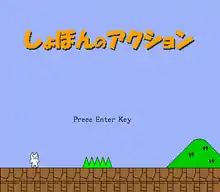Syobon Action
Syobon Action[lower-alpha 1], also known as Cat Mario and Mario from Hell,[1] is a Japanese freeware platform game released in February 2007. It is known for its levels designed to cause extreme frustration due to innocuous-looking objects that suddenly kill the character.[1][2] The game is a parody of Super Mario Bros. for the Nintendo Entertainment System.
| Syobon Action | |
|---|---|
 Title screen | |
| Developer(s) | Chiku |
| Series | Super Mario (unofficially) |
| Platform(s) | Microsoft Windows |
| Release | February 2007 |
| Genre(s) | Platform |
| Mode(s) | Single-player |
Gameplay
The player controls a kitten-like character (with an appearance similar to Toro Inoue) who must venture through side-scrolling platform levels similar to Super Mario Bros. The game consists of four levels (six in the online version) riddled with traps designed to trick the player, and abuse their previous knowledge of Super Mario Bros. gameplay, including normal-looking ground tiles that fall away into pits, blocks that sprout spikes when touched, enemies that spawn nearly on top of the character, deadly background scenery, coin blocks rigged at the edge of a pit to cause the character to fall down, and a Mario-style flagpole that kills the character in two different ways. Despite the surprise factor of these traps, the levels do not change between plays, allowing the player to memorize their locations and patterns and eventually make progress. Some designers have commented on how the game requires the player to think logically through trial-and-error in order to complete the game. The player has infinite lives to allow for this.[2]
Development
Syobon Action was released as freeware for Windows in February 2007.[3] The game was designed by independent Japanese game developer "Chiku", and was inspired by The Big Adventure of Owata, a similar game released through the Japanese 2channel message board a year prior.[3] Chiku chose to make his game a spoof of Super Mario Bros. due to its massive recognition and popularity.[3] The first stage was completed in three days and presented at a cultural festival hosted at his college campus, becoming the most popular work presented.[3] Music was taken from The Cheetahmen, a minigame part of the 1990 NES compilation Action 52. Other music tracks originate from Spelunker, Puyo Puyo, Ghosts 'n Goblins, and Transformers: Mystery of Convoy.[3] A video showcasing the demo was uploaded to his Niconico account a few days later and garnered over 1000 views shortly after, which prompted Chiku to make the demo a full game.[3] Three new stages were produced within the span of two weeks.[3]
Reception
Syobon Action was generally received positively, though the reviews note the intense and often frustrating difficulty of the game.[2][4][5][6] It was recognized as a game that "systematically disrupts every convention of 2D platform gameplay",[1] and that success in the game often relies on both trial-and-error-like strategies and the player's ability to use counterintuitive strategies to avoid obstacles.[2] Open Syobon Action was downloaded alone via Sourceforge.net over 130,000 times between 2010 and October 2018.[7]
See also
Notes
The title screen's Japanese text is misspelled as "しょほんのアクション" (Kunrei-shiki: Syohon no Akusyon); as the third Hiragana character in the title screen is missing a dakuten.
References
- Bogost, Ian. "Persuasive Games: Video Game Pranks". Gamasutra. Retrieved 17 August 2012.
- Patton, Ryan (2010). "Obstructing the view: An argument for the use of obstructions in art education pedagogy". The Journal of Social Theory In Art Education. 30: 49–59. Archived from the original on 2013-10-13.
- Chiku (13 July 2010). "しょぼんのアクションについてのどーでもいい話". GeoCities. Archived from the original on 19 July 2010. Retrieved 14 November 2019.
- Rasmussen, Povl. "Er det her verdens dårligste spil?" (in Danish). PC World Denmark. Retrieved 17 August 2012.
- Dave. "Syobon Action: un jeu hardcore de Mario Bros pour la Wii!" (in French). Amériquébec. Archived from the original on 24 April 2014. Retrieved 17 August 2012.
- "Game Reviews | Free Games | Independent Games | Game Culture". Play This Thing!. Retrieved 2012-08-16.
- stats 2000-05-16+to+2018-10-30 on sourceforge.net (May 2017)